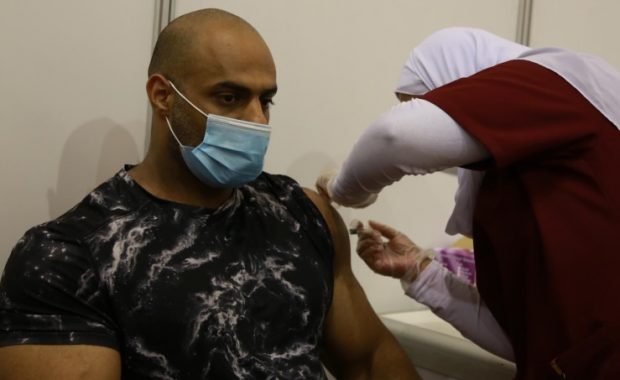To be or not to be (vaccinated) – That is the question!

A Bahraini man getting vaccinated in Manama. Bahrain has witnessed a remarkable turnout for COVID-19 vaccine (BNA)
By Crispin Maslog
MANILA: The double good news is that vaccine hesitancy is going down as the Covid-19 vaccines are being rolled out in the United States, Canada and Europe.
A recent global survey shows that majority of the world’s population is now willing to take the vaccines. The survey involving 13,426 respondents in 19 countries was conducted by Nature Medicine journal in June 2020.
According to the survey, 71.5% of participants would be very or somewhat likely to take a COVID-19 vaccine and 61.4% would accept their employer’s recommendation to do so. The respondents were a random sample of the populations of 19 countries that comprise around 55% of the global population.
Confirming these relatively high acceptance findings is another survey by Pew Research Center, conducted Nov. 18 to 29, 2020 among 12,648 U.S. adults. This Pew survey says that six-in-ten Americans or 60 % say they would surely or maybe get a coronavirus vaccine today, an increase of 9 percentage points compared to 51% in September.
The worsening pandemic coupled with positive news about the development of the first two vaccines from Pfizer-BionTech and Moderna may have contributed to the rising percentage of acceptance of the vaccines as a way out.
It is interesting to note that more English-speaking Asian Americans in the U.S. say they would definitely or probably get vaccinated (83%), according to the Pew Center survey.
The global survey, on the other hand, says vaccine acceptance ranges from a high of almost 90% (in China) to less than 55% (in Russia). Respondents reporting higher levels of trust in government information sources were more likely to accept a vaccine and take their employer’s advice to do so.
Authoritarian nations show higher vaccine acceptance
The global survey adds that authoritarian Asian nations with strong central governments (China, South Korea and Singapore) tended to be more willing to accept vaccines–these countries had acceptance rates exceeding 80%. There was also a relatively high tendency toward acceptance in middle-income countries, such as Brazil, India and South Africa.
The early good news was that governments have started rolling out the Covid-19 vaccine by the tens of millions of doses in Europe and North America. The rest of the world will follow shortly and in six to twelve months if all goes well, we should start to subdue the pandemic.
The first vaccines authorized in the United States, U.K. and Canada is the one developed by the pharmaceutical giant Pfizer and a small company, BioNTech. It is expected to also be approved by the European Union in a matter of weeks.
Two other vaccines are close behind–one developed by Moderna and the U.S. National Institutes of Health, and another from AstraZeneca and the University of Oxford. Half a dozen or more vaccines are expected to be approved in the next few months. Most of the inoculations would require two injections, weeks apart.
So as 2021 unfolds, which vaccines someone gets will vary by country, depending on the speed of approvals, the deals governments have made to buy supplies and how much the vaccines cost.
The goal is to vaccinate enough people in the population in each country in order to attain herd immunity. Roughly 60% to 90% of a population needs to be vaccinated for a disease to achieve herd immunity.
The threshold of immunization is specific to each disease, ranging roughly between 60% to 90% of the population. Once herd immunity is achieved, the pandemic subsides and disappears. The question is will enough people accept the vaccine to achieve herd immunity? At the rate vaccine hesitancy is going down, it is possible.
We need to get vaccines to the poor
Even with lower vaccine hesitancy, however, one problem remains—poverty. It may bog down the immunization program if we do not do anything about it.
Around 1.89 billion people, or nearly 36% of the world’s population, live in extreme poverty and most people cannot afford the vaccine which costs $10 per vaccination at the cheapest.
Unless governments and the private sectors collaborate to give free vaccinations or bring the prices down, the vaccination campaign will struggle to succeed.
This early, however, this problem is being addressed by governments, the United Nations and by regional financial organizations like the Asian Development Bank.
At the same time, philanthropy by the wealthy sectors in these poorer countries is pitching in. In the Philippines and Cambodia, to cite just two examples, the private sector (business companies, wealthy businessmen and philanthropists) has agreed to fund vaccinations for the poor.
There also is COVAX, a global consortium with more than two-thirds of the world engaged by the World Health Organization (WHO) to manage the acquisition and distribution of COVID-19 vaccines. It includes governments, global health organisations, manufacturers, scientists, private sector, civil society and philanthropy working together to provide equitable access to COVID-19 diagnostics, treatments and vaccines.
With more than 180 member-countries, COVAX — an initiative worth US$18 billion — aims to have two billion doses of vaccine available by the end of 2021, which should be enough to protect high-risk and vulnerable people, as well as frontline healthcare workers.
There is indeed light at the end of the tunnel—although it is a very long tunnel.
- Crispin Maslog is a former journalist with Agence France-Presse and science journalism professor at Silliman University and University of the Philippines Los Banos. He is now Chair of the Board, Asian Media Information and Communication Centre, based in Manila.
























































